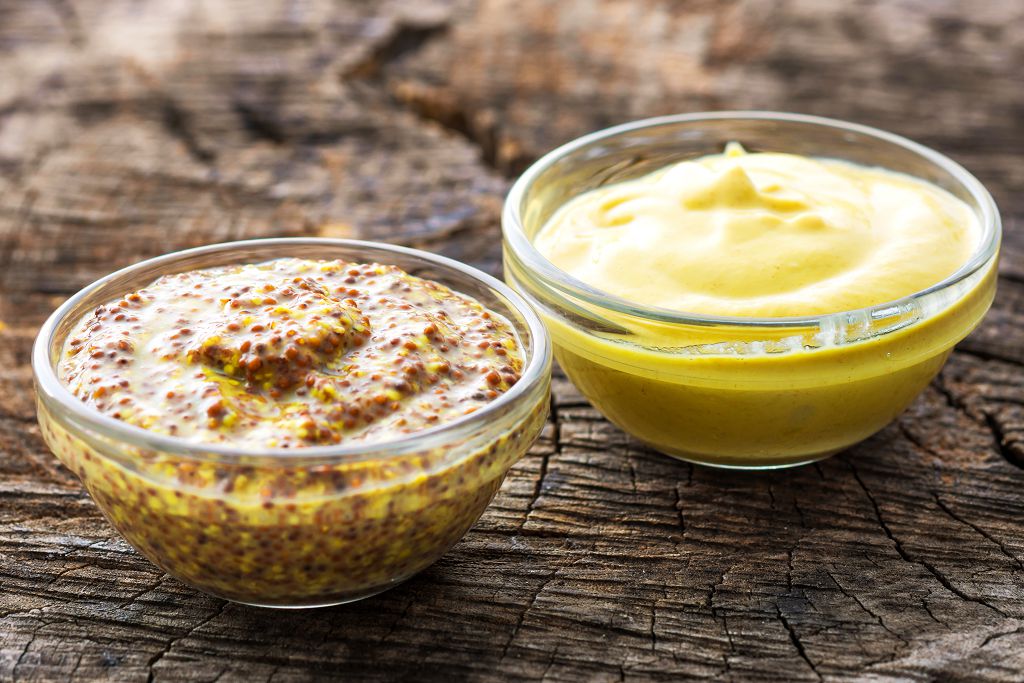Mustard Overview
Mustard is a condiment made from the seeds of a mustard plant. Commonly paired with meats and cheeses, mustard is also added to sandwiches, hamburgers, corn dogs, and hot dogs. It is also used as an ingredient in many dressings, glazes, sauces, soups, and marinades. As a cream or as individual seeds, mustard is used as a condiment in the cuisine of India and Bangladesh, the Mediterranean, northern and southeastern Europe, Asia, the Americas, and Africa, making it one of the most popular and widely used spices and condiments in the world.
Mustard Type
English mustard
It is bright yellow in color with a thicker consistency than the mild American mustard. The most famous brand of English mustard is Colman's, which first produced their variety in 1814 as a powder in their yellow tin. William Taylor, based in Newport Pagnell, was the first person to sell English mustard in a prepared format in 1830.
French mustard
Not to be confused with French's mustard.
This dark brown, mild, and tangy/sweet mustard, despite its name, is not French in origin. "French" mustard is particular to the UK and was invented by Colman's in 1936. It became a popular accompaniment to steak in particular. Colman's ceased production of French mustard in 2001 after Unilever, which now own Colman's, were ordered to stop selling it by the EU, following its takeover of rival mustard-maker Amora Maille in 2000. Many British supermarkets still offer their own version of French mustard.
The most commonly used mustard in the United States – and tied with Dijon in Canada – is American mustard sold as "yellow mustard" (although most prepared mustards are yellow) and commonly referred to as just "mustard". A very mild prepared mustard colored bright yellow from turmeric powder, it was supposedly introduced in 1904 by George J. French as "cream salad mustard". American mustard is regularly used to top hot dogs, sandwiches, pretzels, and hamburgers. It is also an ingredient of many potato salads, barbecue sauces, and salad dressings. It is commonly referred to as "hot dog", "ballpark", "yellow", "sunshine", or "prepared" mustard for these applications. In Austria, it is called Amerikanischer Senf (American mustard) and is regarded as much milder than local varieties.
How to Storage Mustard
Prepared mustard is sold in glass jars, plastic bottles, or metal squeeze tubes. Because of its antibacterial properties, mustard does not require refrigeration for safety; it will not grow mold, mildew, or harmful bacteria. Mustard can last indefinitely without becoming inedible or harmful, though it may dry out, lose flavor, or brown from oxidation. Mixing in a small amount of wine or vinegar may improve dried-out mustard. Some types of prepared mustard stored for a long time may separate, which can be corrected by stirring or shaking. If stored unrefrigerated for a long time, mustard can acquire a bitter taste. When whole mustard seeds are wetted and crushed, an enzyme is activated that releases pungent sulfurous compounds; but they quickly evaporate. An acidic liquid, such as wine or vinegar, produces a longer-lasting paste. However, even then prepared mustard loses its pungency over time; the loss can be slowed by keeping a sealed container (opaque or in the dark) in a cool place or refrigerator.
Things you don’t know about mustard
- Broccoli is a not-so-distant cousin.
As members of Brassica or Sinapis genera, mustard plants are close relatives to a surprising variety of common vegetables, including broccoli, cauliflower, turnips, and cabbage.
- It’s said to be America’s silver-medal spice.
Peppercorns are the most used spice in the United States; mustard comes in second.
- “Mustard yellow” is a lie!
The particular shade of yellow to which mustard lends its name owes its hue not to mustard seeds themselves, but to the vibrantly colored turmeric added for an extra kick of spice and brightness. Crushed mustard seeds alone vary from a pale yellow to a dark brown depending on their variety, but “turmeric yellow” doesn’t sound quite as good.
Mustard Benefits
The Greeks and Romans were on to something when they used mustard seeds for medicinal purposes. The mustard plant, like broccoli, radish, and cabbage, belongs to the brassica family, a group of vegetables that contain health-promoting glucosinolates. Enzymes in the seeds then break these down into isothiocyanates. These compounds give mustard its eye-watering pungency, and many studies now suggest that they also seem to inhibit the growth of cancer cells, most notably in the gastrointestinal tract and colon. Mustard seeds are an excellent source of selenium, a trace element that is also thought to have an anti-cancer effect.UK soils are generally low in selenium so eating mustard, and mustard seeds can help boost your selenium level.
Related Articles
Search
Categories
Popular Posts




















Comments: 0
No comments